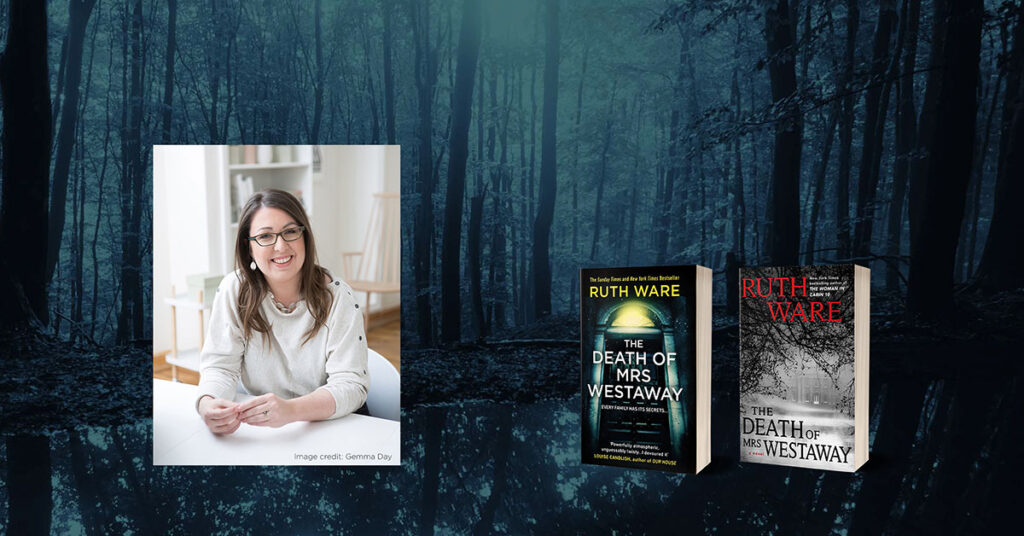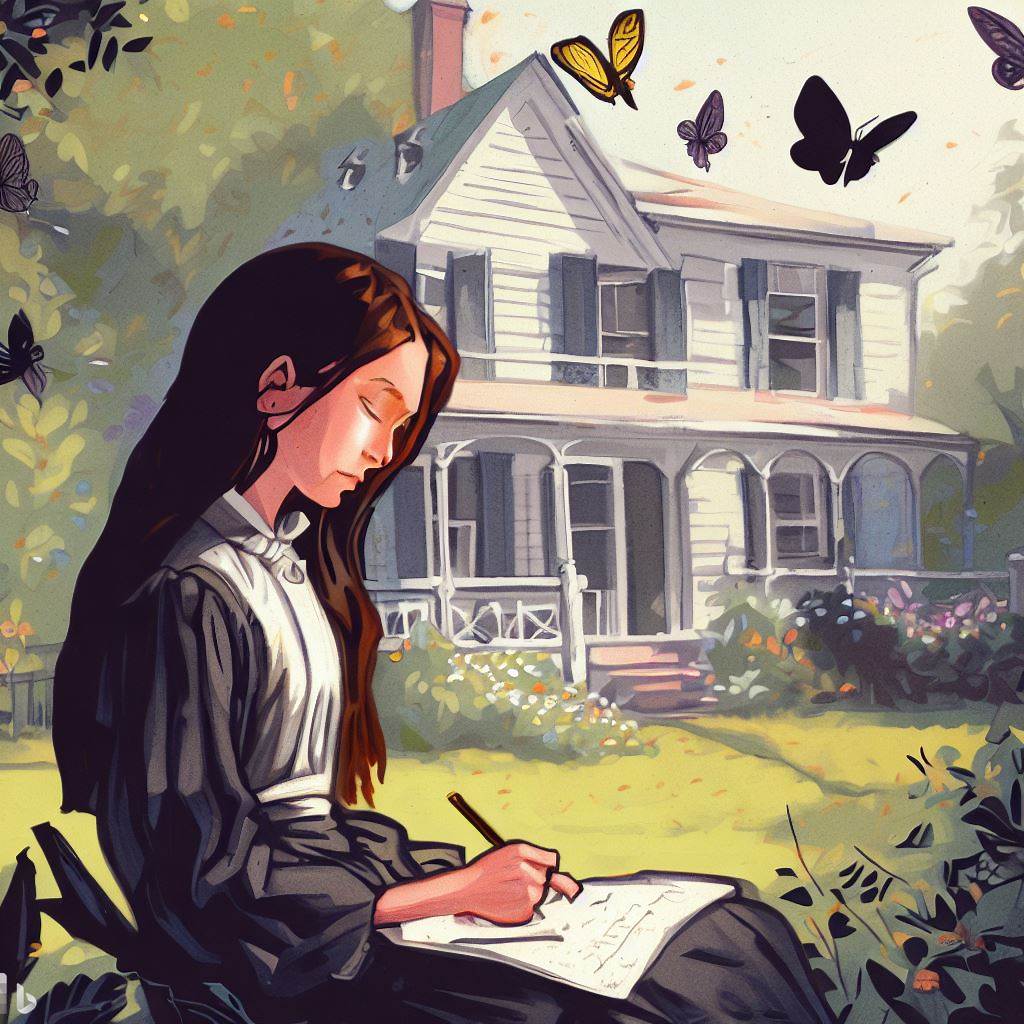Ruth Ware has established herself as a master of modern psychological thrillers, weaving intricate plots with complex characters, and creating a literary universe that keeps readers on the edge of their seats. Each of Ware’s novels is a testament to her prowess in the thriller genre, combining suspense, mystery, and often a touch of the gothic. In this article, we delve deep into Ruth Ware’s body of work, exploring each book’s unique contributions to her literary universe, and examining how they collectively define her as a formidable voice in contemporary thriller fiction.
1. In a Dark, Dark Wood (2015)
Plot Overview: “In a Dark, Dark Wood” marks Ruth Ware’s debut into the literary world, and it sets the tone for her subsequent works. The novel follows Leonora “Nora” Shaw, a reclusive crime writer who reluctantly accepts an invitation to a bachelorette party for her estranged friend, Clare Cavendish. The gathering is held in a glass house in a remote forest, which becomes the perfect setting for the suspense that ensues.
Thriller Elements: The novel excels in creating an atmosphere of claustrophobia and tension. The isolated setting amplifies the psychological unease, and the narrative structure, which alternates between past and present, keeps readers guessing about the true nature of events. Ware’s use of unreliable narration heightens the suspense, as Nora’s memory is fragmented and unclear, leading to a shocking revelation that ties her past to the current crisis.
Character Development: Nora is a complex protagonist whose inner turmoil and past traumas are central to the narrative. Ware skillfully unpacks her psychological state, making her both sympathetic and enigmatic. The secondary characters, particularly Clare, are equally well-drawn, contributing to the novel’s intricate web of relationships and secrets.
2. The Woman in Cabin 10 (2016)
Plot Overview: “The Woman in Cabin 10” is perhaps Ware’s most famous work, catapulting her into the spotlight. The story centers on Lo Blacklock, a travel journalist who embarks on a luxury cruise. What should have been a dream assignment turns nightmarish when Lo believes she witnesses a woman being thrown overboard. However, all passengers and crew are accounted for, leading Lo to question her own sanity.
Thriller Elements: Ware masterfully utilizes the confined setting of a cruise ship to create a sense of entrapment and paranoia. The novel plays with themes of isolation and trust, as Lo struggles to convince others of her story while doubting her own perceptions. The pacing is relentless, with Ware expertly building tension through cliffhangers and red herrings.
Character Development: Lo Blacklock is a compelling protagonist whose anxiety and determination drive the narrative. Ware delves into Lo’s psychological landscape, exploring her past traumas and how they influence her current predicament. The supporting cast is also vividly portrayed, adding layers of suspicion and complexity to the story.

3. The Lying Game (2017)
Plot Overview: In “The Lying Game,” Ware shifts her focus to a group of women bound by a dark secret from their school days. The story is told from the perspective of Isa Wilde, who, along with her three friends, was involved in a game of lies that led to dire consequences. When a body is discovered, the women are forced to confront their past and the lies that have defined their lives.
Thriller Elements: The novel is steeped in atmosphere, with the coastal setting and the decaying boarding school creating a sense of foreboding. Ware uses flashbacks effectively to unravel the mystery, maintaining a delicate balance between past and present. The tension is palpable as the truth slowly emerges, revealing the depth of the characters’ deceit and guilt.
Character Development: Isa Wilde is a richly drawn character whose narrative voice conveys both vulnerability and strength. Ware explores themes of friendship, loyalty, and betrayal, with each character’s motivations and fears meticulously crafted. The dynamic between the women adds emotional weight to the thriller elements, making the eventual resolution all the more impactful.
4. The Death of Mrs. Westaway (2018)
Plot Overview: “The Death of Mrs. Westaway” pays homage to the classic gothic thriller. The story follows Harriet “Hal” Westaway, a tarot card reader who receives a mysterious letter informing her of a substantial inheritance. Despite knowing the letter was sent to her by mistake, Hal decides to attend the funeral of the deceased, Mrs. Westaway, hoping to uncover the truth and possibly secure the inheritance.
Thriller Elements: The novel is imbued with gothic elements, from the eerie mansion to the secrets lurking within the Westaway family. Ware’s use of atmosphere is particularly effective, creating a sense of dread that permeates the narrative. The plot twists are carefully plotted, with each revelation adding to the mounting suspense.
Character Development: Hal is an intriguing protagonist whose struggle for survival and moral dilemmas add depth to the story. Ware’s portrayal of the Westaway family is equally compelling, with each member harboring secrets and motives that complicate Hal’s quest for the truth. The interplay between Hal’s tarot readings and the unfolding mystery adds a unique layer to the narrative.
5. The Turn of the Key (2019)
Plot Overview: Inspired by Henry James’s “The Turn of the Screw,” “The Turn of the Key” is a modern retelling that stands on its own merits. The novel is presented as a series of letters from Rowan Caine, who is in prison awaiting trial for the murder of a child in her care. Rowan recounts her experience as a live-in nanny at a high-tech house in the Scottish Highlands, where she becomes entangled in a series of inexplicable and terrifying events.
Thriller Elements: Ware’s use of technology as a source of horror is particularly effective in this novel. The smart house, with its surveillance and automated systems, creates a pervasive sense of intrusion and unease. The narrative structure, which reveals the outcome from the beginning, enhances the suspense as readers are compelled to piece together the events leading to the tragic conclusion.
Character Development: Rowan Caine is a nuanced protagonist whose reliability is constantly questioned. Ware deftly explores her psychological state, making her a sympathetic yet ambiguous figure. The children she cares for and the enigmatic Elincourt family add to the complexity of the narrative, each contributing to the sense of mystery and dread.

6. One by One (2020)
Plot Overview: “One by One” takes inspiration from Agatha Christie’s classic “And Then There Were None,” set in a modern context. The novel follows a group of employees from a tech startup who gather at a luxury ski chalet in the French Alps for a corporate retreat. When an avalanche cuts off their access to the outside world, the group must deal with rising tensions and the realization that a killer is among them.
Thriller Elements: The remote, snowbound setting is a classic thriller trope that Ware uses to great effect. The isolation and harsh environment heighten the sense of danger, while the group dynamics provide a rich source of conflict and suspicion. The pacing is brisk, with the body count rising as secrets are revealed and alliances shift.
Character Development: Ware excels in depicting a diverse cast of characters, each with distinct personalities and hidden agendas. The dual narrative perspectives, from Erin the chalet host and Liz, a former employee of the company, provide a multifaceted view of the events. This structure allows for deeper character exploration and keeps readers engaged as the mystery unfolds.
7. The It Girl (2022)
Plot Overview: “The It Girl” returns to the theme of past secrets resurfacing in the present. The novel follows Hannah Jones, whose university days were marred by the murder of her roommate and friend, April Clarke-Cliveden. A decade later, new evidence emerges suggesting that the man convicted of the crime may have been innocent, prompting Hannah to reexamine the events that led to April’s death.
Thriller Elements: The setting of an elite university provides a backdrop of privilege and power, contrasting with the dark undercurrents of jealousy and betrayal. Ware uses a dual timeline to great effect, revealing the complexities of Hannah’s relationships and the pressures of university life. The suspense builds steadily as Hannah uncovers long-buried truths and faces the possibility that the real killer is still at large.
Character Development: Hannah is a relatable and compelling protagonist, whose journey from guilt and uncertainty to determination and courage is central to the narrative. Ware’s portrayal of April as the charismatic yet flawed “It Girl” adds depth to the story, highlighting the impact she had on those around her. The secondary characters, including Hannah’s university friends and April’s family, are well-developed, contributing to the novel’s emotional and psychological complexity.
8. Zero Days (2023)
Plot Overview: “Zero Days” introduces a new protagonist, Jack, a penetration tester who, along with her husband Gabe, specializes in exposing vulnerabilities in security systems. Their latest job takes a deadly turn when Jack returns home to find Gabe murdered. As the prime suspect, Jack goes on the run, determined to uncover the truth and clear her name.
Thriller Elements: Ware incorporates elements of cybercrime and high-stakes espionage, blending them with her signature psychological suspense. The cat-and-mouse chase across London is filled with tension and action, while the mystery of Gabe’s murder unfolds through a series of twists and revelations. The technological aspects add a modern twist to the traditional thriller format.
Character Development: Jack is a resilient and resourceful protagonist whose grief and determination drive the narrative. Ware explores her relationship with Gabe through flashbacks, adding emotional depth to the story. The supporting characters, including law enforcement and potential allies, are well-drawn, enhancing the complexity of the plot and the stakes involved.

Thematic and Stylistic Continuities
Ruth Ware’s novels are characterized by their atmospheric settings, intricate plots, and deeply developed characters. She often employs unreliable narrators, dual timelines, and isolated settings to heighten suspense and create a sense of unease. Themes of trust, betrayal, and the impact of past traumas recur throughout her work, providing a cohesive thread that binds her literary universe.
Conclusion
Ruth Ware’s contributions to the thriller genre are significant and enduring. Each of her novels offers a unique exploration of human psychology and the darkness that can lurk beneath the surface of everyday life. Through her masterful storytelling and keen insight into character, Ware has created a literary universe that continues to captivate and thrill readers worldwide. Her ability to blend traditional thriller elements with contemporary issues and settings ensures that her work remains relevant and engaging, solidifying her place as a leading voice in modern thriller fiction.









